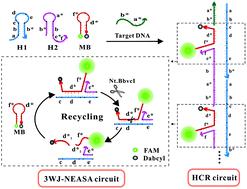Our official English website, www.x-mol.net, welcomes your
feedback! (Note: you will need to create a separate account there.)
A highly sensitive fluorescence biosensor for detection of Staphylococcus aureus based on HCR-mediated three-way DNA junction nicking enzyme assisted signal amplification
Analyst ( IF 3.6 ) Pub Date : 2021-08-29 , DOI: 10.1039/d1an01335a Chuyan Zhang 1 , Zewei Luo 2 , Mengfan Wu 3 , Wei Ning 1 , Ziyi Tian 1 , Yixiang Duan 3 , Yongxin Li 1
Analyst ( IF 3.6 ) Pub Date : 2021-08-29 , DOI: 10.1039/d1an01335a Chuyan Zhang 1 , Zewei Luo 2 , Mengfan Wu 3 , Wei Ning 1 , Ziyi Tian 1 , Yixiang Duan 3 , Yongxin Li 1
Affiliation

|
Sensitive and efficient monitoring of food-borne bacteria is of great importance for food safety control. Herein, a novel biosensor for highly sensitive detection of Staphylococcus aureus (S. aureus) was constructed by combining hybridization chain reaction (HCR) and nicking enzyme. Different from the upstream-downstream based circuit, the proposed biosensor integrated HCR circuit and three-way DNA junction nicking enzyme assisted signal amplification (3WJ-NEASA) into a virtuous circle of promotion. In the HCR-mediated 3WJ-NEASA sensing strategy, target DNA of S. aureus initiated the self-assembly between HCR hairpins (H1 and H2), which exposed the gap to capture molecular beacon (MB) and construct the 3WJ structure. Meanwhile, MB increased the stability of HCR nanowires and enhanced the efficiency of the HCR circuit, and thus more 3WJ-NEASA circuits were generated in HCR nanowires. Benefiting from the synergistic amplification coupling HCR and 3WJ-NEASA, this isothermal biosensor can detect as low as 6.7 pM of target DNA in one step within only 30 min. Furthermore, the HCR-mediated 3WJ-NEASA assay has been applied in the detection of S. aureus with a limit of detection (LOD) as low as 1.2 × 101 cfu mL−1, and has exhibited reliable practicability in spiked milk. It is the first time that a DNA biosensor combining HCR and 3WJ-NEASA for dual signal amplification was developed and has been adopted to the sensitive analysis of food-borne bacteria. Additionally, this strategy can serve as a universal platform for monitoring other analytes, and therefore possesses broad application prospects in food safety and environmental monitoring.
中文翻译:

基于HCR介导的三路DNA连接切口酶辅助信号放大的高灵敏度荧光生物传感器检测金黄色葡萄球菌
灵敏有效地监测食源性细菌对食品安全控制具有重要意义。在此,结合杂交链反应(HCR)和切口酶构建了一种用于高灵敏度检测金黄色葡萄球菌(S. aureus)的新型生物传感器。与基于上下游的电路不同,所提出的生物传感器将HCR电路和三路DNA连接切口酶辅助信号放大(3WJ-NEASA)集成到一个良性循环中。在 HCR 介导的 3WJ-NEASA 传感策略中,靶向金黄色葡萄球菌的DNA启动 HCR 发夹(H1 和 H2)之间的自组装,暴露间隙以捕获分子信标(MB)并构建 3WJ 结构。同时,MB增加了HCR纳米线的稳定性,提高了HCR电路的效率,从而在HCR纳米线中产生了更多的3WJ-NEASA电路。受益于 HCR 和 3WJ-NEASA 的协同放大耦合,这种等温生物传感器可以在 30 分钟内一步检测低至 6.7 pM 的目标 DNA。此外,HCR 介导的 3WJ-NEASA 检测已应用于金黄色葡萄球菌的检测,检测限 (LOD) 低至 1.2 × 10 1 cfu mL -1,并在加标牛奶中表现出可靠的实用性。首次开发出结合HCR和3WJ-NEASA双信号放大的DNA生物传感器,并应用于食源性细菌的灵敏分析。此外,该策略可以作为监测其他分析物的通用平台,因此在食品安全和环境监测方面具有广阔的应用前景。
更新日期:2021-09-27
中文翻译:

基于HCR介导的三路DNA连接切口酶辅助信号放大的高灵敏度荧光生物传感器检测金黄色葡萄球菌
灵敏有效地监测食源性细菌对食品安全控制具有重要意义。在此,结合杂交链反应(HCR)和切口酶构建了一种用于高灵敏度检测金黄色葡萄球菌(S. aureus)的新型生物传感器。与基于上下游的电路不同,所提出的生物传感器将HCR电路和三路DNA连接切口酶辅助信号放大(3WJ-NEASA)集成到一个良性循环中。在 HCR 介导的 3WJ-NEASA 传感策略中,靶向金黄色葡萄球菌的DNA启动 HCR 发夹(H1 和 H2)之间的自组装,暴露间隙以捕获分子信标(MB)并构建 3WJ 结构。同时,MB增加了HCR纳米线的稳定性,提高了HCR电路的效率,从而在HCR纳米线中产生了更多的3WJ-NEASA电路。受益于 HCR 和 3WJ-NEASA 的协同放大耦合,这种等温生物传感器可以在 30 分钟内一步检测低至 6.7 pM 的目标 DNA。此外,HCR 介导的 3WJ-NEASA 检测已应用于金黄色葡萄球菌的检测,检测限 (LOD) 低至 1.2 × 10 1 cfu mL -1,并在加标牛奶中表现出可靠的实用性。首次开发出结合HCR和3WJ-NEASA双信号放大的DNA生物传感器,并应用于食源性细菌的灵敏分析。此外,该策略可以作为监测其他分析物的通用平台,因此在食品安全和环境监测方面具有广阔的应用前景。











































 京公网安备 11010802027423号
京公网安备 11010802027423号